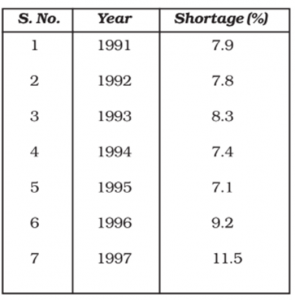NCERT Solutions for Class 8 Science Chapter 5 – Coal and Petroleum, contains solutions to various questions in Exercise for Chapter 5. At the end of the Solutions, all the keywords and Notes which are important to understand Science Chapter 5 – Coal and Petroleum, have been explained in a simple and easy to understand manner. NCERT Solutions for Class 8 help to check the concept you have learnt from detailed classroom sessions and application of your knowledge.
| Category | NCERT Solutions for Class 8 |
| Subject | Science |
| Chapter | Chapter 5 – Coal and Petroleum |
Download NCERT Solutions for Class 8 Science Chapter 5 – Coal and Petroleum
NCERT Solutions for Class 8 Science Chapter 5 – Coal and Petroleum – NCERT Exercises
Question 1
What is the advantage of using CNG and LPG as fuel?
Answer 1.
The advantage of using CNG and LPG as fuel are –
- They are cleaner fuels and do not produce smoke when burnt.
- CNG and LPG powered vehicles have lower maintenance cost.
- They produce a lot of heat energy when burnt thus are more efficient.
- They can be easily transported through pipelines.
Question 2
Name the petroleum product used for surfacing of roads.
Answer 2.
Bitumen is the petroleum product used for surfacing of roads nowadays. It has replaced coal-tar.
Question 3
Describe how coal is formed from dead vegetation. What is this process called?
Answer 3.
Millions of years ago, the forests got buried under the earth due to various natural phenomena such as floods, earthquakes and tectonic movements. Over the years, these forests got buried under layers of soil which compressed these forests and under the intense heat and pressure these got converted into coal. The process of conversion of dead vegetation into coal is called carbonisation.
NCERT Solutions for Class 8 Science Chapter 5 – Coal and Petroleum – Video Explanation
Question 4
Fill in the blanks:
(a) Fossil fuels are ____, ______ and ________.
(b) Process of separation of different constituents from petroleum is called _________.
(c) Least polluting fuel for vehicle is _________.
Answer 4.
(a) Fossil fuels are coal, petroleum and natural gas.
(b) Process of separation of different constituents from petroleum is called refining.
(c) Least polluting fuel for vehicle is Compressed Natural Gas (CNG).
Question 5
Tick True/False against the following statements:
(a) Fossil fuels can be made in the laboratory.
(b) CNG is more polluting fuel than petrol.
(c) Coke is almost pure form of carbon.
(d) Coal tar is a mixture of various substances.
(e) Kerosene is not a fossil fuel.
Answer 5.
(a)False
(b)False
(c)True
(d)True
(e)False
Question 6
Explain why fossil fuels are exhaustible natural resources?
Answer 6.
Fossil Fuels are the Non-Renewable energy resources that is they cannot be replaced once exhausted. The fossil fuels like petroleum take hundreds of million of years to form and are available for only about a hundred years. Thus they will run out if not used wisely.
Question 7
Describe the characteristics and uses of coke.
Answer 7.
Characteristics of coke:
- It is a black organic fuel and is hard and highly porous.
- It is almost a pure form of carbon
- It is manufactured using the destructive distillation process.
Uses of coke:
- It is used as a fuel for blacksmithing.
- It is used as a reducing agent in smelting iron in a blast furnace.
- It is used in the extraction of many metals.
Question 8
Explain the process of formation of petroleum.
Answer 8.
Petroleum was formed by the decomposition of dead organic matter millions of years ago. When the forests and other organic matter decayed and got covered up in layers of sand , soil and clay then due to the high pressure and temperature conditions, the matter decayed and transformed into fossil fuels such as petroleum, coal and natural gas.
Question 9
The following Table shows the total power shortage in India from 1991–
- Show the data in the form of a graph. Plot shortage percentage for
the years on the Y-axis and the year on the X-axis.

Answer 9.

Topics Covered in Chapter Chapter 5 Coal and Petroleum Class 8 Science :-
- Coal
- Petroleum
- Natural Gas
- Some Natural Resources are Limited
Important Terms Relevant to understand NCERT Solutions for Class 8 Science Chapter 5 Coal and Petroleum:-
Inexhaustible Natural Resources: These are the resources available in nature that are present in an infinite amount and won’t run out after their use by the population like sunlight and air.
Exhaustible Natural Resources: These are the natural resources which are present in a limited amount and will get exhausted over time like coal, petroleum, forests etc.
Carbonisation: The process of conversion of dead vegetation into coal is referred to as carbonisation.
Petroleum: It is yellowish-black thick liquid that Is formed by the decomposition of the dead organic matter buried under the earth million of years ago. It is also known as ‘black gold’
NCERT Solutions for Class 8 Science
- Crop Production and Management
- Microorganisms: Friend and Foe
- Synthetic Fibres and Plastics
- Materials : Metals and Non-Metals
- Coal and Petroleum
- Combustion and Flame
- Conservation of Plants and Animals
- Cell Structure and Functions
- Reproduction in Animals
- Reaching the Age of Adolescence
- Force and Pressure
- Friction
- Sound
- Chemical Effects of Electric Current
- Some Natural Phenomena
- Light
- Stars and The Solar System
- Pollution of Air and Water